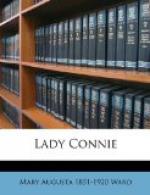Meanwhile—what was not so evident to this large-hearted observer—Otto was more than willing—he burned—to play his part. All that is mystical and passionate in the soul of a Polish Catholic, had been stirred in him by his accident, his growing premonition of short life, the bitterness of his calamity, the suddenness of his change of heart towards Falloden.
“My future is wrecked. I shall never live to be old. I shall never be a great musician. But I mean to live long enough to make Constance happy! She shall talk of me to her children. And I shall watch over her—perhaps—from another world.”
These thoughts, and others like them, floated by day and night through the boy’s mind; and he wove them into the symphony he was writing. Tragedy, passion, melody—these have been the Polish heritage in music; they breathe through the Polish peasant songs, as through the genius of a Chopin; they are bound up with the long agony of Polish history, with the melancholy and monotony of the Polish landscape. They spoke again through the beautiful thwarted gift of this boy of twenty, through his foreboding of early death, and through that instinctive exercise of his creative gift, which showed itself not in music alone, but in the shaping of two lives—Falloden’s and Connie’s.
* * * * *
And Constance too was living and learning, with the intensity that comes of love and pity and compunction. She was dropping all her spoilt-child airs; and the bower-bird adornments, with which she had filled her little room in Medburn House, had been gradually cleared away, to Nora’s great annoyance, till it was almost as bare as Nora’s own. Amid the misty Oxford streets, and the low-ceiled Oxford rooms, she was played upon by the unseen influences of that “august place,” where both the great and the forgotten dead are always at work, shaping the life of the present. In those days Oxford was still praising “famous men and the fathers who begat” her. Their shades still walked her streets. Pusey was not long dead. Newman, the mere ghost of himself, had just preached a tremulous last sermon within her bounds, returning as a kind of spiritual Odysseus for a few passing hours to the place where he had once reigned as the most adored son of Oxford. Thomas Hill Green, with the rugged face, and the deep brown eyes, and the look that made pretence and cowardice ashamed, was dead, leaving a thought and a teaching behind him that his Oxford will not let die. Matthew Arnold had yet some years to live and could occasionally be seen at Balliol or at All Souls; while Christ Church and Balliol still represented the rival centres of that great feud between Liberal and Orthodox which had convulsed the University a generation before.




